
Charleroi is a city and a municipality of Wallonia, located in the province of Hainaut, Belgium. The city is situated in the valley of the Sambre, in the south-west of Belgium, not far from border with France. By 1 January 2008, the total population of Charleroi was 201,593. The metropolitan area, including the outer commuter zone, covers an area of 1,462 square kilometres (564 sq mi) with a total population of 522,522 by 1 January 2008, ranking it as the 5th most populous in Belgium after Brussels, Antwerp, Liège, and Ghent. The inhabitants are called Carolorégiens or simply Carolos.
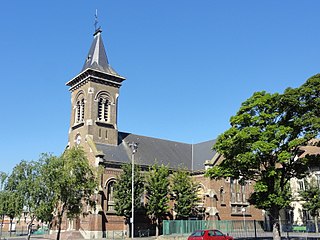
Liévin is a commune in the Pas-de-Calais department in northern France. The inhabitants are called Liévinois.
A mining accident is an accident that occurs during the process of mining minerals or metals. Thousands of miners die from mining accidents each year, especially from underground coal mining, although accidents also occur in hard rock mining. Coal mining is considered much more hazardous than hard rock mining due to flat-lying rock strata, generally incompetent rock, the presence of methane gas, and coal dust. Most of the deaths these days occur in developing countries, and rural parts of developed countries where safety measures are not practiced as fully. A mining disaster is an incident where there are five or more fatalities.

The Borinage is an area in the Walloon province of Hainaut in Belgium. The name derives from the coal mines of the region, bores meaning mineshafts. In French the inhabitants of the Borinage are called Borains.

The Monongah mining disaster of Monongah, West Virginia occurred on December 6, 1907, and has been described as "the worst mining disaster in American history." 362 miners were killed. The explosion occurred in Fairmont Coal Company’s No. 6 and No. 8 mines, and was one of the contributing events leading to the creation of the United States Bureau of Mines.

The Courrières mine disaster, Europe's worst mining accident, caused the death of 1,099 miners in Northern France on 10 March 1906. This disaster was surpassed only by the Benxihu Colliery accident in China on 26 April 1942, which killed 1,549 miners. A coaldust explosion, the cause of which is not known with certainty, devastated a coal mine operated by the Compagnie des mines de houille de Courrières. Victims lived nearby in the villages of Méricourt, Sallaumines, Billy-Montigny, and Noyelles-sous-Lens. The mine was 2 km (1 mi) to the east of Lens, in the Pas-de-Calais département.

The L'Innovation fire was a fire that took place at the À L'Innovation department store on the Rue Neuve/Nieuwstraat in central Brussels, Belgium, on 22 May 1967. More than 150 firefighters were mobilised to fight it, 325 people were killed, 80 injured, and the department store itself, the work of the Art Nouveau architect Victor Horta, was destroyed.

Marcinelle is a town of Wallonia and a district of the municipality of Charleroi, located in the province of Hainaut, Belgium.
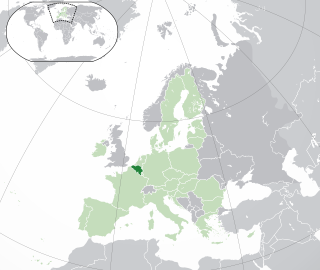
Euro gold and silver commemorative coins are special euro coins minted and issued by member states of the Eurozone, mainly in gold and silver, although other precious metals are also used in rare occasions. Belgium was one of the first twelve countries in the Eurozone that introduced the euro (€) on 1 January 2002. Since then, the Belgian Royal Mint have been minting both normal issues of Belgian euro coins, which are intended for circulation, and commemorative euro coins in gold and silver.

Tiberio Murgia was an Italian film actor. He appeared in more than 100 films between 1958 and 2009.
Hainaut-Sambre was a Belgian group of steel companies based in the Charleroi region, it was founded in 1955 by the merger of Usine Métallurgiques du Hainaut, and the metal making division of Sambre et Moselle.
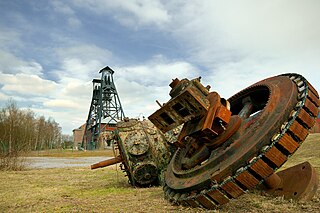
The Major Mining Sites of Wallonia is a UNESCO World Heritage Site comprising four sites in Wallonia in southern Belgium associated with the Belgian coal mining industry of the 19th and 20th centuries. The four sites of the grouping, situated in the French-speaking Hainaut Province and Liège Province, comprise Grand-Hornu, the Bois-du-Luc, the Bois du Cazier and Blegny-Mine.

The Nord-Pas-de-Calais Mining Basin is a mining basin in Northern France that stretches across the Nord and Pas-de-Calais departments. The region is famous for its long history of coal extraction and its testimony to a significant period in the history of industrialisation in Europe, and as a result it was inscribed on the UNESCO World Heritage List in 2012. This area has been shaped by three centuries of coal extraction from the late 17th century through the 20th century, and demonstrates the evolution of coal mining techniques and worker conditions during that time.
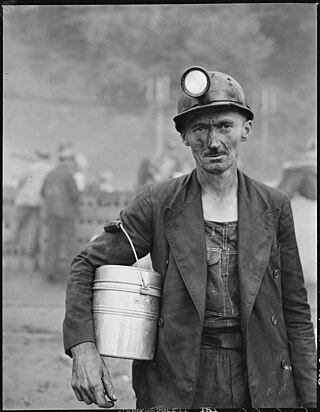
People have worked as coal miners for centuries, but they became increasingly important during the Industrial revolution when coal was burnt on a large scale to fuel stationary and locomotive engines and heat buildings. Owing to coal's strategic role as a primary fuel, coal miners have figured strongly in labor and political movements since that time.

The Beringen coal preparation plant is a part of the former Beringen coal mine, which is located in Beringen in the Belgian province of Limburg. Since 1994, the building has been selected and protected as mining heritage by the Flemish government, and is planned to be reused as part of the Flemish Mining Museum. The mining site of Beringen was one of the Belgian anchor points of the ERIH. A coal preparation plant separates the usable coal from the waste rock. This coal preparation plant is one of the biggest and last vast examples of the Belgian coal industry.

On 13 May 2014, blasting at Eynez coal mine in Soma, Manisa, Turkey, caused an underground mine fire, which burned until 15 May. In total, 301 people were killed in what was the worst mine disaster in Turkey's history. The mine, operated by coal producer Soma Kömür İşletmeleri A.Ş., suffered a fire, the causes of which were later found to be complex. The fire occurred at the mine's shift change, and 787 workers were underground at the time. At the time the disaster was thought to be mainly an explosion rather than fire. After the final bodies were pulled from the mine on 17 May 2014, four days after the fire, the Minister of Energy and Natural Resources Taner Yıldız confirmed the number of dead was 301. Disaster and Emergency Management Presidency (AFAD) announced the names of 301 workers who died in the mine disaster and 486 people who survived.
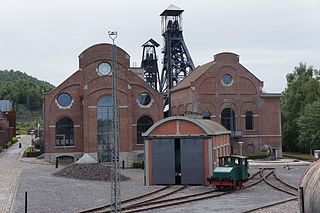
The Bois du Cazier was a coal mine in what was then the town of Marcinelle, near Charleroi, in Belgium which today is preserved as an industrial heritage site. It is best known as the location of a major mining disaster that took place on August 8, 1956 in which 262 men, including a large number of Italian labourers, were killed. Aside from memorials to the disaster, the site features a small woodland park, preserved headframes and buildings, as well as an Industrial Museum and Glass Museum. The museum features on the European Route of Industrial Heritage and is one of the four Walloon mining sites listed by UNESCO as a World Heritage Site in 2012.

The Compagnie des mines d'Anzin was a large French mining company in the coal basin of Nord-Pas-de-Calais in northern France. It was established in 1756 and operated for almost 200 years.

















